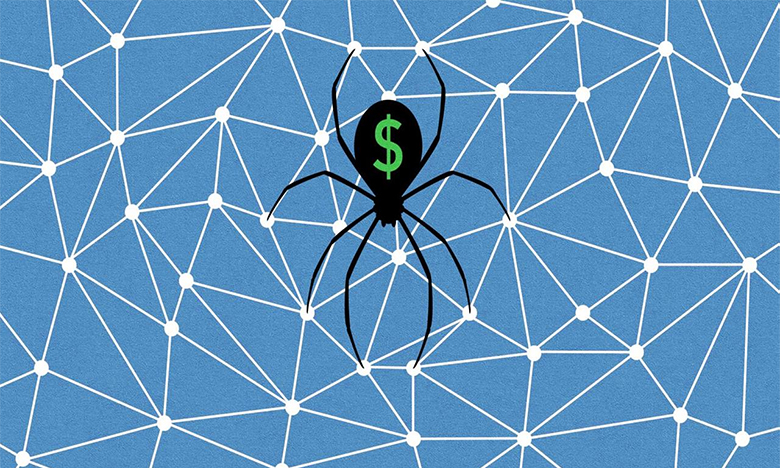When you’re buying or selling your bonds, stocks and derivatives — OK, when your banker or broker makes those trades on behalf of your pension fund or mutual fund — how much time do you spend thinking about how money actually moves from one person to another, and how financial assets make their way back in the other direction? Come to think of it, how much money do you spend on commissions to the middlemen who make it all happen?
Well, time to listen up, because a new technology headed for Wall Street (and pretty much every other industry) could change how transactions work at their most basic building blocks — literally.
Known collectively as blockchain, these new systems use “distributed ledgers” to provide networkwide platforms for frictionless exchanges. Think of a distributed ledger as a gigantic Google Doc that everyone can access — a universal record-keeping system. But crucially, instead of agreeing on a transaction and then having a middleman (or a regulator or a government) verify, approve, record, time-stamp and facilitate it, and then conduct the transaction for you, in a blockchain-based network, anyone can add to the shared ledger, and then that record is the verification — and the transaction.
Got it? Great.
So what’s at stake here? On Wall Street, blockchain could upend how institutions trade with one another. One example: It could shrink the three days that it currently takes to clear a securities transaction into seconds. It could also enable entirely new forms of exchange — think self-enforcing contracts and, yes, digital currency. Indeed, “blockchain will do for transactions what the internet did for information,” IBM CEO Ginni Rometty said at a conference in Geneva in September. Extending Rometty’s analogy, it should be noted that it’s early days for blockchain, with developers still establishing the ground rules for the equivalents of the TCP/IP language protocols that allowed the internet to become the internet.
But despite all the anarchistic rumblings that the end is nigh for Wall Street intermediaries, here’s the surprising reality: The three leading consortia vying to establish shared protocols — Hyperledger, R3 and the Ethereum Enterprise Alliance — count among their members old-school titans such as JPMorgan Chase, Wells Fargo, Barclays, Bank of America, Deutsche Bank and HSBC. Admittedly, there are a bunch of quirky-sounding tech startups there too, from Bloq to Infrachain, as well as surprising big brands like BP, Microsoft and Airbus. The fact remains, though, that on Wall Street the blockchain revolution won’t be disruption from the outside, but instead “the most meaningful adoptions have been when the intermediaries are disrupting themselves,” says Javier Paz, a senior analyst at research and advisory firm Aite Group.
"HYPERLEDGER IS ANTICIPATING A WORLD OF MANY DIFFERENT [BLOCK]CHAINS, A WORLD WHERE THERE WILL BE SIGNIFICANT GOVERNANCE DIFFERENCES BETWEEN THESE CHAINS."
Take the Depository Trust & Clearing Corp. It’s the organization that clears and settles the majority of worldwide securities trades, which means it handles annual transactions worth more than $1.5 quadrillion, from which the private company generates annual revenue of nearly $2 billion. The largest financial bookkeeper in the world, the DTCC is “one of the intermediaries that blockchain could easily wipe out,” says Paz. And yet one of the products furthest ahead in turning blockchain-based platforms into reality is the DTCC’s own project to automate record keeping, life cycle events and payment management in the credit derivatives market. The project is expected to launch in 2018, the DTCC’s managing director of IT architecture, Robert Palatnick, tells OZY. Counters Paz: “It’s a reluctant adoption.”
So why is the ultimate disruption coming from within? Because of its distributed, crowd-based nature, “blockchain is a technology that requires cooperation to exist,” says Paz, “but so far we haven’t seen the vision of banks, of brokers, of asset managers or of brokerages to be in sync.” Hence the emergence of major consortia to respond to that coordination challenge. So, if after the blockchain revolution there’s still a need for a DTCC-style industrywide figure to establish protocols, provide governance, mediate disputes and update the digital infrastructure, “why not use the old one?” Paz asks. “The best direction for distributed ledger technology is open source, with open, interoperable protocols and standards,” says the DTCC’s Palatnick, so “there is a need for central authorities to play a leading role in introducing [this] governance process.”
Achieving this consensus has been the major stumbling block as the earliest blockchain-based systems — cryptocurrency networks like bitcoin — try to transition into universal platforms for secure exchange. In reality, the potential for blockchain is “a little more prosaic” than the early visions of a single, universal, public, crowd-based platform, says Brian Behlendorf, executive director of Hyperledger, a leading consortium that supports a variety of open-source blockchain technology projects. “Hyperledger is anticipating a world of many different [block]chains,” he says, “a world where there will be significant governance differences between these chains, and likely also technical differences.”
Of course, it’s not all going to stay within the Wall Street old boys’ club — some Silicon Valley players are muscling in on the action, including Chain, a 3-year-old VC-backed startup that creates blockchain-based infrastructure for financial services and has so far partnered with Nasdaq and Visa, among others. And while the concept of communitywide consortia building open-source projects together might be familiar in the tech world, “trying to get a car company or a bank to think about participating in that cycle … is a challenge,” says Behlendorf, “but increasingly they are getting it.”
So, while many have dreamed of shaking up the financial services leviathan, Wall Street itself might turn out to be the ultimate fintech disrupter. Which raises the question — if not blockchain, then what?

